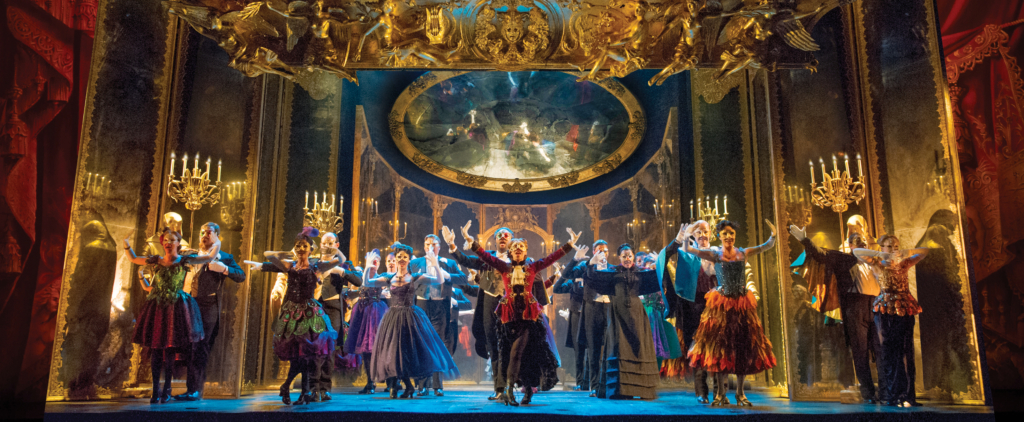Night time sharpens, heightens each sensation…darkness wakes and stirs imagination…open up your mind…let your fantasies unwind…because it’s here— The Phantom of the Opera! The much-awaited, long anticipated return of Andrew Lloyd Webber’s musical masterpiece, wearing its new-age millennial skin, The New Production of The Phantom of The Opera tells Broadway’s most haunting love-adjacent story with much more smoke and whistles for the new age of theatergoers. Directed by Laurence Connor with Choreography by Scott Ambler, Cameron Mackintosh’s new presentation gives diehard fans much to contemplate while inviting the next generation to arrive and embrace Broadway’s longest running spectacle.
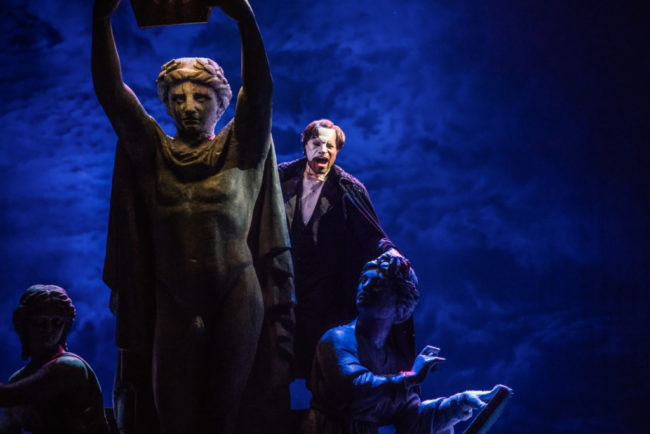
The touring production itself is re-invented. The music and plotline, for the most part, have stayed true to Andrew Lloyd Webber’s original book, and most certainly has followed to the letter Webber’s original score. The intentions and character motivations, concepts of scenes and staging have all been newly remodeled to feature a grandiose array of special effects and pyrotechnics. If one, bearing no previous knowledge or awareness of The Phantom of the Opera, were to take in this current touring production as a brand new musical debut, it might be assessed that the focus of the performance tends to be spectacle heavy, with plot, music, and character development taking a backseat to all the bells, whistles, and fire-showers of the show.
Uncompromisably the best production element of the performance is the flawless sound design and balance crafted with precision expertise by Sound Designer Mick Potter. Part of the enigmatic mysticism and thrill of the Phantom character is his ubiquity, unseen and yet vocally everywhere. Potter has aligned the speakers throughout the venue to perfection, allowing a surround-sound experience like no other, convincing the audience that the Phantom is where he sounds to be coming from, so much so that you’ll experience a bit of whiplash flipping your head about trying to catch a glimpse of him. Swells of sound and balance of pit to singers on stage is excellently achieved thanks to Potter’s sound design. At this performance, the pit was under the direction of Jamie Johns and while the music itself sounded glorious— every haunting note exactly as remembered by anyone who has ever heard the score before— there were numbers where the tempo slogged along, most notably “Notes/Prima Donna” and “Notes/Twisted Every Way.” Whether this was an intentional use of ritenuto on Johns’ behalf in an attempt to ensure that the gregarious lyrics were understood in these numbers (which regrettably they were not, as there are just too many voices in varying harmonies, several of which were somewhat lacking in articulation) or simply a misguided tempo, remains unclear, but the sluggish pacing of these numbers was noted to be unpleasant.
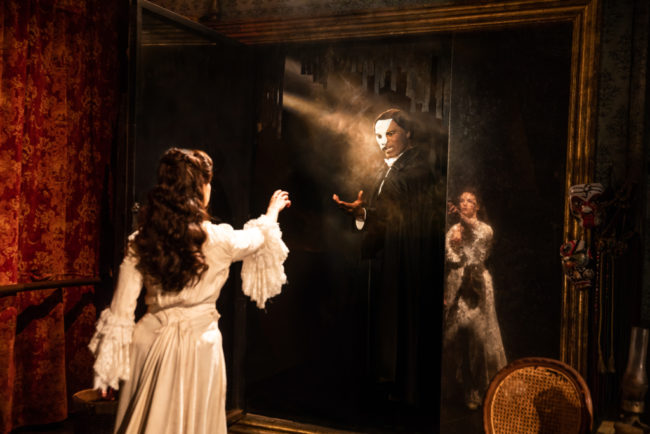
Focusing only on the production as a stand-alone incarnation, rather than as a comparison to the grandeur of what the show once was, the new production poses a great many questions about the designs and concepts as a whole. For every astonishing feature— like the float-vanishing staircase that leads down to the Phantom’s labyrinth— there is a highly questionable one— like the filthy mirrors in both the ballet-rehearsal room and at the masquerade ball, where at least the latter would have been polished to a brilliant shine given the celebratory nature of the event. (I suppose those deeply invested might argue that the new managers of Paris Opera House spent all their money on a new chandelier and could not afford to have the mirrors cleaned before the ball.)
Set Designer Paul Brown does have somewhat of a darkly whimsical set, particularly when it comes to the aforementioned staircase, as well as the Phantom’s lair. One of Brown’s most impressive set pieces is the “hellfire piano” which not only plays itself but torch-lights in fury with high-bursting flames. This is, another strangely questionable move in Mackintosh’s new vision, as the blocking and lighting cues in this moment seem to imply that no one else on the stage but Christine can see the piano bursting into flames and playing itself…furthering the sentiment that this Phantom fellow is all in her head.
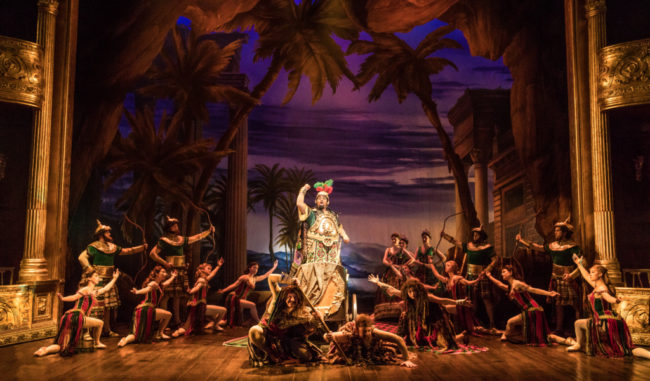
Costume Designer Maria Björnson leaves much to the imagination where costumes for the show are concerned. While the radiant red and green beads of the Hannibal opera scene are resplendent, Björnson’s sartorial selections fall somewhat short of the grandeur expected during numbers like “Masquerade.” When the mirrors split apart and The Phantom appears himself at the end of this number, wearing a bejeweled version of his own mask and something akin to a costume piece borrowed from Les Miserables, it begs the question of what exactly was Björnson going for with this look? But on the flipside, Björnson takes great pride and care when it comes to outfitting the prima donna La Carlotta. Her outfits are outlandish, almost to a fever pitch of fashion, particularly the cookies-and-crème grayscale affair that is mouth-watering in all of its elegance.
Scott Ambler’s choreography is sloppy and leaves much to be desired. This could be intentional, making the Ballet Chorus of the Opera Populaire appear to be deserving of Madam Giry’s unrelenting wrath. However, it does not explain the general chaos featuring during the “Masquerade” number. Ambler’s choreography isn’t the only thing amiss with this number; background chatter can be heard— prominently here but also at various other points throughout the performance— to a level of distraction from what the principals are singing. Christine and Raoul’s micro-fight during “Masquerade” is all but lost to this background rumble of ensemble chittering away at a party. It feels out of place, sounds distasteful and distracts from the music, lyrics, and performance as a whole.
This is one of the broader issues with the production— there’s too much talking. And the talking often coincides with contrived punches of humor. Monsieur Firmin (David Benoit) and Monsieur André (Rob Lindley) are the ring leaders of this crime, ad-libbing little bits of nonsense, turning the pair into Punch-N-Judy clowns. Benoit’s portrayal of Firmin leads the audience to believe he’s perpetually plastered, and toddling around like the town drunk who just happened into co-owning/running an opera house. The audience seems to enjoy the hijinks of Benoit and Lindley, even if it feels forced and out of place with the rest of the show.
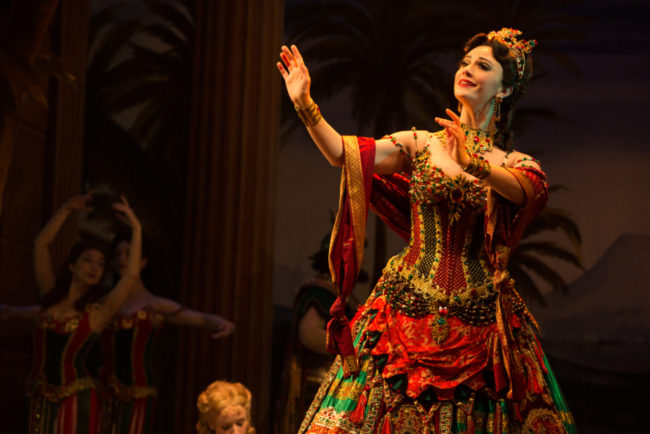
Stealing each scene into which she struts, Trista Moldovan reigns supreme as the leading soprano Carlotta Giudicelli. Her physical comportment, her ferocious facial expressions, everything about Moldovan’s performance screams supreme Divatude. There is no denying she has mastered the role of Prima Donna extraordinaire. Moldovan, who is given the delicious vocal accessory of Phumzile Sojola as Ubldo Piangi, commands a stage and everyone on it. When belting out her bits in peak soprano form, Moldovan exudes talent and composure befitting of her character. Even her vocal affectation as the highly plush opera soprano fits the bill. Her aria, “Think of Me” and her headstrong solo-lead-in during “Notes/Prima Donna” are vocally impressive.
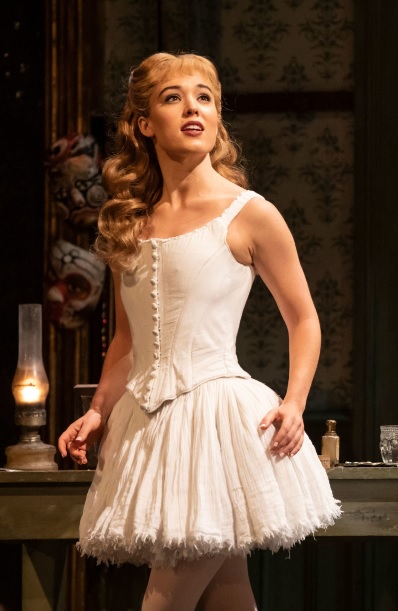
Stealing the scene in a much subtler and more meager manner, SarahGrace Mariani deftly slides Meg Giry onto the radar of existence. With Andrew Lloyd Webber’s sequel, Love Never Dies, presumably in the ether of awareness of the original production (because the sequel presented quite a few glaringly obvious incongruities of plot and character to the original Phantom of the Opera), the role of Meg Giry takes on a larger weight of importance. No longer the simple ballet friend and daughter of the ballet mistress, this Meg Giry is a secretive protector of The Phantom, tipped off by Christine’s strange behavior. Mariani exhibits this in the way she appears during “Down Once More/Track Down This Murderer” and even earlier when she adds sweet vocal simplicity to “Angel of Music” a duet with Christine.
Again aligning with the notion that a sequel exists, Raoul is not the tender, ardent lover the script might once have implied him to be. Calloused, pushy, ill-tempered and almost mean-spirited, there is little passion present in this incarnation of Raoul (Jordan Craig.) And while Craig has a voice, and some semblance of pitch, it is not a voice that well-serves this character. His nasal-forward sound creates a grating, whiny aural experience for Raoul’s numbers, which could of course be an intentional choice to further the audience’s distaste for this Raoul. To his credit, Craig’s voice is strong, even if not quite the right fit for the character.
Despite poor blocking choices of Director Laurence Connor, both Christine (Emma Grimsley) and The Phantom (Derrick Davis) far exceed the expectations of their performances. Grimsley and Davis share an extraordinary chemistry, which is volatile and tenuous, uncertain and yet intense. There is a new dynamic, truly stranger than you dreamt it, to the way Christine and The Phantom square off, encounter, and inveigle one another. But this is the most fascinating portion of the new vision that Cameron Mackintosh sets forth. This all seems to be with the sequel in mind, given the rather large, shocking spoiler that arises from Love Never Dies, but it redeems the mysticism and trance-like control over Christine that The Phantom has, which is otherwise all but striped away from the character in this production.
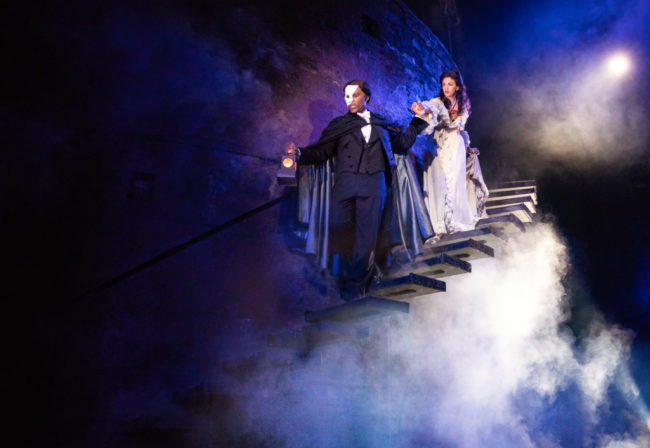
Davis, whose phenomenal voice is a stellar instrument that is both haunting and evocative, is saddled with a misguided individual in this new creation that is The Phantom. Slinking about like a common gutter rat, in this production, The Phantom no longer makes things happen through ghostly magic, but rather is caught in the act every time an accident occurs. Whether this is an attempt to humanize him or simply strip away his sorcery and mysticism, it is a misstep, both failing to trust Andrew Lloyd Webber’s original creation and the current talent that Derrick Davis brings to the role. Forgetting all of the shaky character choices wrapped into this production, Davis’ voice hypnotizes the audience into forgiveness. He is emotionally forward and grounds the mountains of emotions that The Phantom experiences in his powerful vocal instrument.
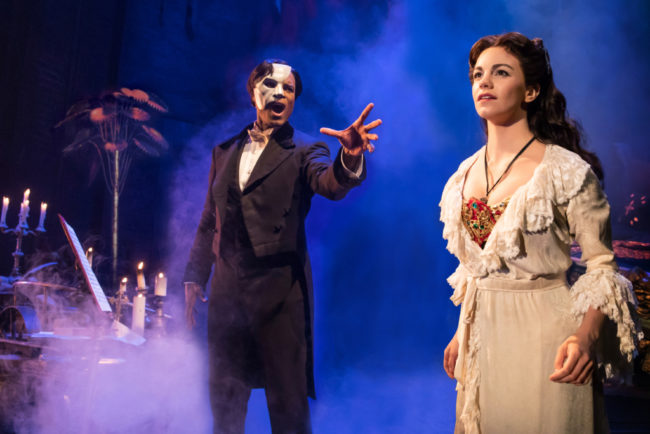
Emma Grimsley is an effortless breeze in the role of Christine. With a fine soprano sound that marries delectably against the robust richness of Derrick Davis’ Phantom, “The Phantom of the Opera” and “Past The Point of No Return” become duets of sheer musical ecstasy, particularly the latter which favors blocking and choreography to promote such feelings. There is a desperate need, a push and pull shared equally and with great emotional depth between Grimsley and Davis all throughout their scenes together, each informing the other when they sing apart. Grimsley, whose tragically beautiful rendition of “Wishing You Were Somehow Here Again” deeply stirs the soul in indescribable ways, is the perfect fit for Christine Daae, and matches flawlessly well against Derrick Davis’ Phantom. The pair and their combined vocal talents, redeem a great many questionable elements of the production, inspiring the new generations of first timers while reassuring the staunch fans that their beloved Phantom is still there.
The Angel of Music is not patient and will only be drifting through Charm City until the 20th of October. See Emma Grimsley as Christine Daae; see Derrick Davis astound audiences as the titular character, watch the spectacle beyond your wildest imagination. The Phantom of the Opera awaits, if you dare.
Running Time: Approximately 2 hours and 35 minutes with one intermission
The Phantom of the Operaplays through October 20, 2019 at Baltimore’s Hippodrome Theatre in the France-Merrick Performing Arts Center— 12 N. Eutaw Street in the Bromo Seltzer Arts District of Baltimore, MD. For tickets call the box office at (410) 752-7444 or purchase them purchase them online.
To read the TheatreBloom interview with SarahGrace Mariani on playing Meg Giry, click here.

